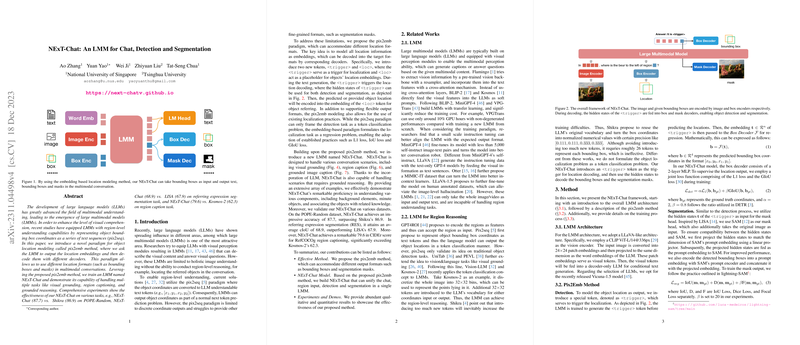An Expert Analysis of "NExT-Chat: An LMM for Chat, Detection, and Segmentation"
The growing intersection of LLMs and visual comprehension has given rise to large multimodal models (LMMs). A notable contribution in this field is the research presented in the paper titled "NExT-Chat: An LMM for Chat, Detection, and Segmentation." The authors introduce a novel paradigm for integrating object location modeling into LMMs through the pix2emb method, which represents a significant evolution from the previous pix2seq method. Where pix2seq converts object coordinates into textual sequences for LMM consumption, pix2emb converts these locations into embeddings, allowing for greater flexibility in location formats such as bounding boxes and segmentation masks.
The paper details the development and capabilities of NExT-Chat, an LMM that incorporates this new pix2emb method to excel in tasks including visual grounding, region captioning, and grounded image captioning. The NExT-Chat model demonstrates significant performance advancements compared to existing models on specific datasets, such as an accuracy of 87.7 on the POPE-Random dataset, outperforming Shikra at 86.9. Also, it achieves an IoU score of 68.9 in referring expression segmentation, surpassing LISA's 67.9, and a CIDEr score of 79.6 for RefCOCOg region captioning, significantly exceeding Kosmos-2’s score of 62.3.
Methodological Innovations
The pix2emb paradigm represents an important methodological shift in how LMMs can process and interpret visual data. By encoding object locations as embeddings rather than discrete text tokens, the NExT-Chat model can handle a variety of tasks more effectively. The model distinguishes itself by integrating tasks that require fine-grained visual understanding, like distinguishing individual objects within an image, rather than treating the image as a whole.
The introduction of <trigger> and <loc> tokens within this model facilitates a dual role in handling both detection and segmentation tasks. This allows the model to output location data in multiple formats without losing the contextual richness needed for subsequent language tasks. The cycle loss method further strengthens the training of the location encoder and decoder, improving the alignment between these components.
Empirical Evaluation
NExT-Chat's performance was evaluated against several benchmarks, where it demonstrated enhanced capabilities in handling region-level tasks. On tasks like visual grounding, the model effectively managed complex queries and demonstrated an ability to reason about object interactions within a scene, outperforming several state-of-the-art baselines.
Implications and Future Directions
This research opens several avenues for future exploration, particularly in reducing the dependency on extensive datasets for training high-accuracy models. The pix2emb method provides a flexible framework that could potentially lower the resource barriers in training future LMM models. Additionally, this method could be extended to handle more complex multimodal tasks, involving dynamic visual data such as videos or 3D scenes.
While the paper indicates significant improvements, the authors note limitations regarding the model's capability to handle multiple image inputs simultaneously and its performance across diverse domains such as medical imaging. Addressing these limitations could significantly broaden the applicability of LMMs in real-world tasks beyond traditional visual understanding frameworks.
In conclusion, the introduction of NExT-Chat demonstrates a noteworthy advance in the integration of language and vision tasks, showcasing how LMMs can evolve to address increasingly complex scenarios. The proposed pix2emb method offers a template for future research aiming to enhance the interpretability and contextual understanding within multimodal AI.
